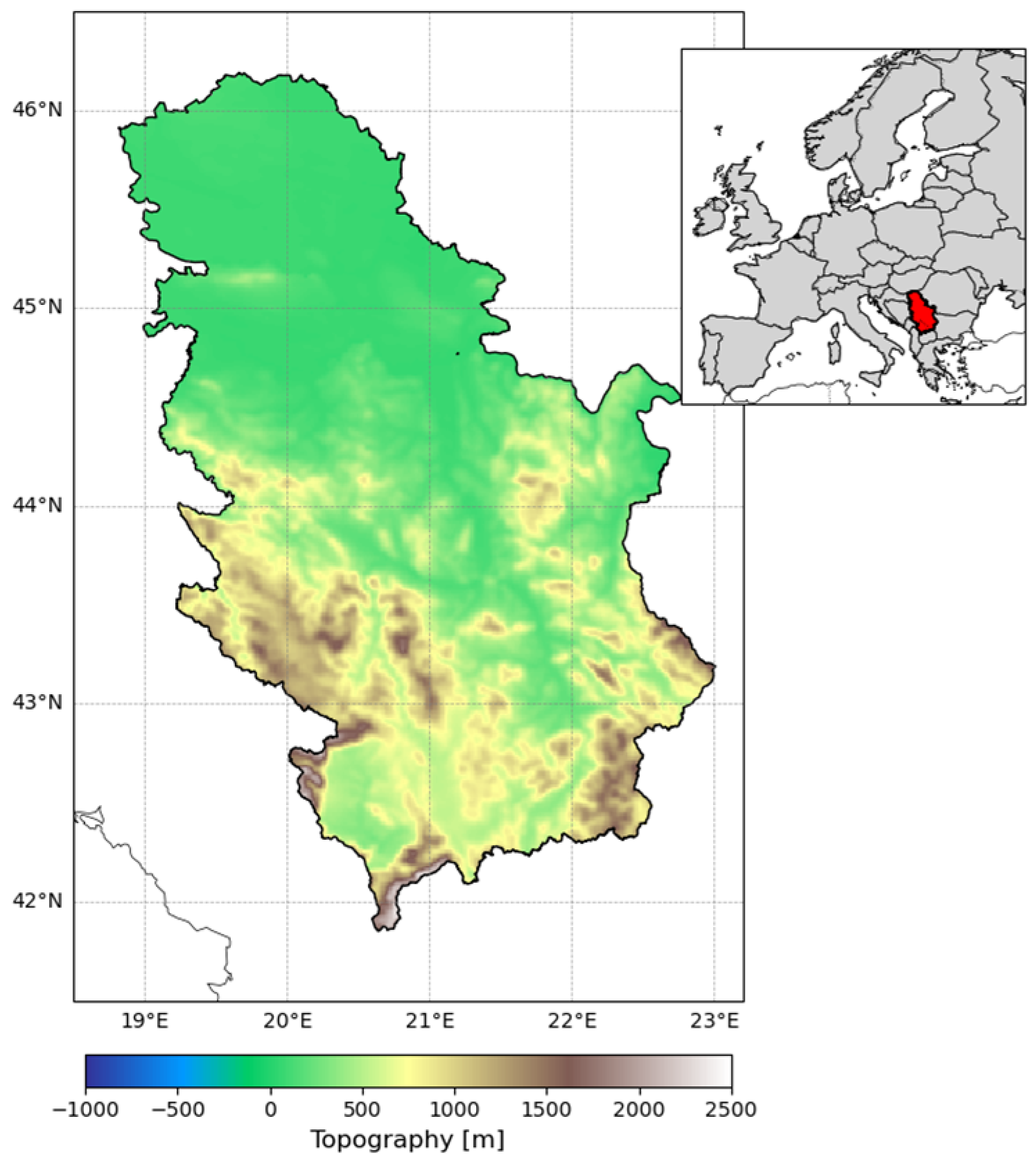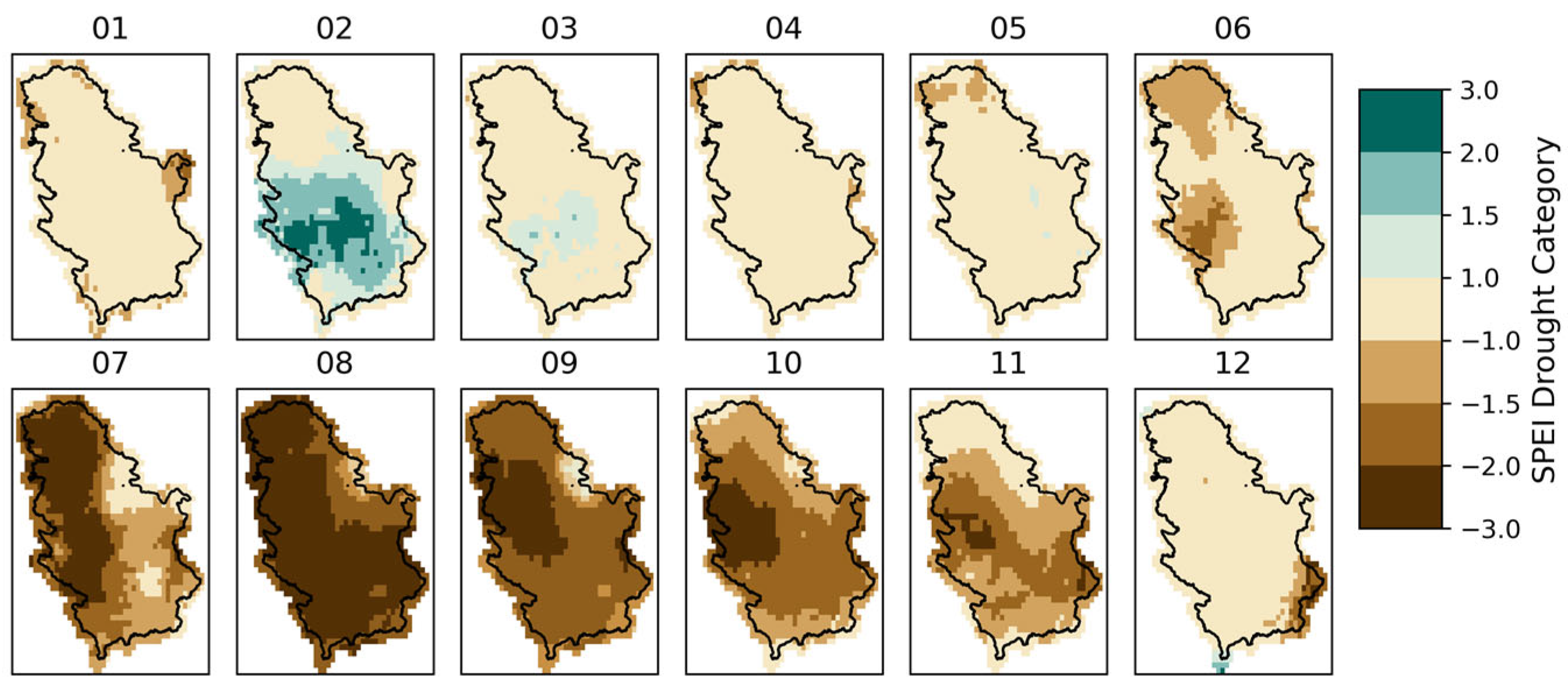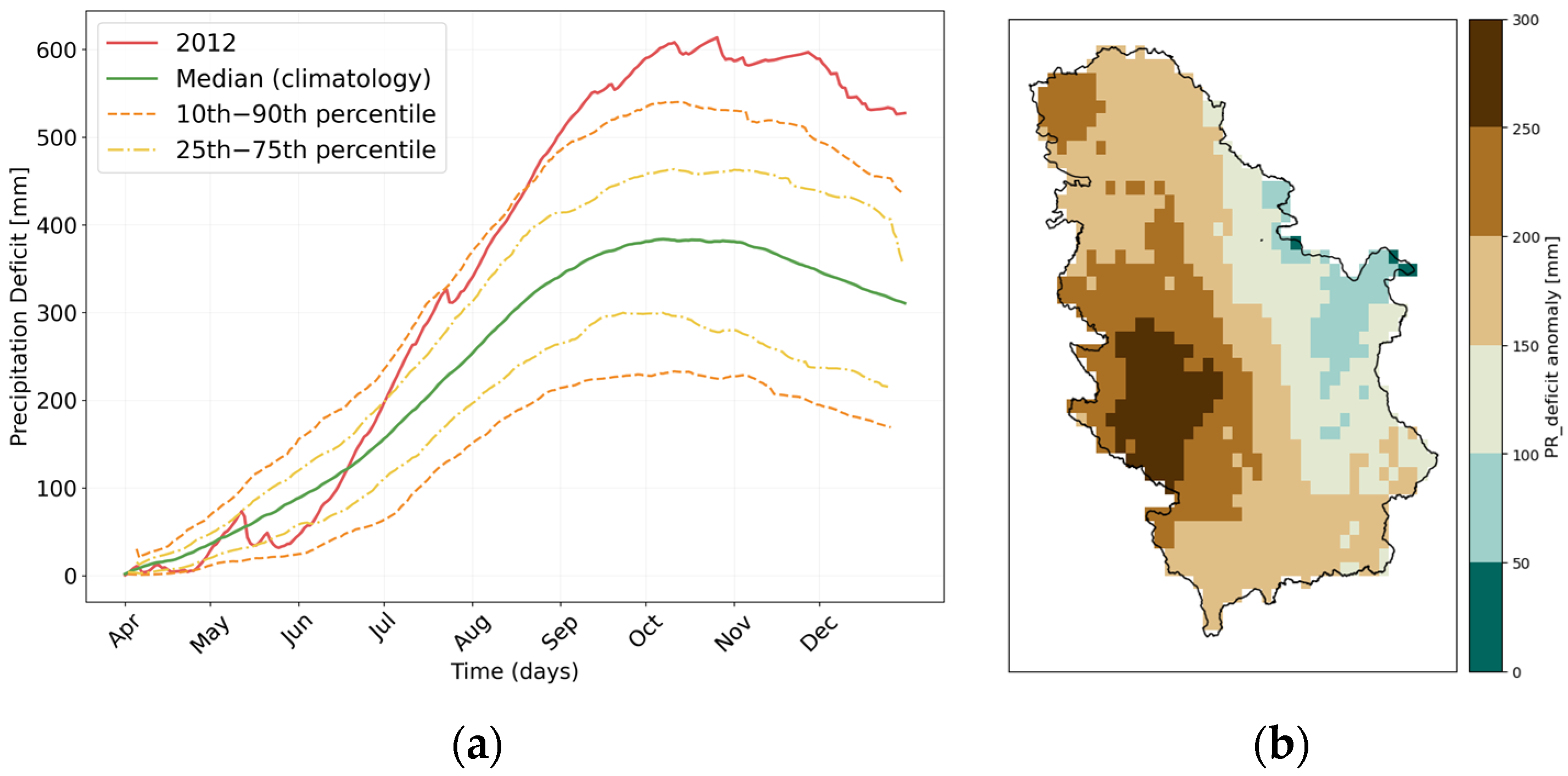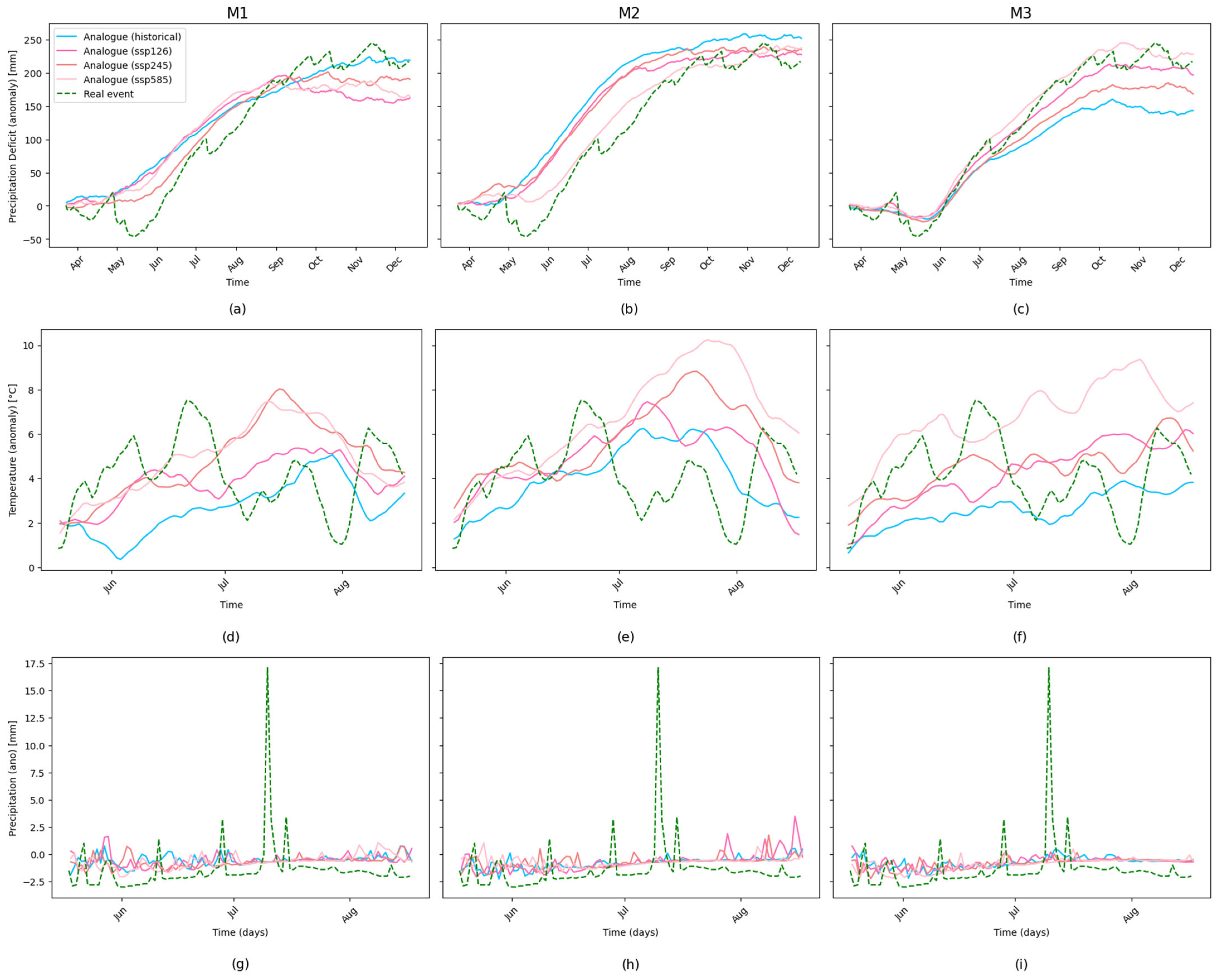Reconstructing and Projecting 2012-like Drought in Serbia Using the Max Planck Institute Grand Ensemble
Abstract
:1. Introduction
2. Materials and Methods
2.1. Study Area and Data
2.1.1. Study Area
2.1.2. Data
- -
- SSP1-2.6 assumes strong mitigation and sustainability efforts, leading to low radiative forcing by 2100;
- -
- SSP2-4.5 represents an intermediate pathway with moderate emissions and adaptation challenges, achieving a forcing level of 4.5 W m−2;
- -
- SSP5-8.5 corresponds to high fossil fuel use and minimal mitigation, resulting in high-end emissions and radiative forcing of 8.5 W m−2 in 2100.
2.2. Methods
2.2.1. Drought Metrics Based on Precipitation Deficit
2.2.2. The Standardized Precipitation Evapotranspiration Index (SPEI)
2.2.3. Analogue Selection Process and Criteria
3. Results
3.1. Reconstruction of the 2012 Drought in Historical Data
3.2. How Well Does MPI-GE Reproduce the Observed Climatology?
3.3. Detection of Analogous Drought Events in the Large Ensemble
3.4. Changes in Precipitation Deficit Metrics Across Scenarios
4. Discussion and Conclusions
Supplementary Materials
Author Contributions
Funding
Institutional Review Board Statement
Informed Consent Statement
Data Availability Statement
Acknowledgments
Conflicts of Interest
Abbreviations
| LE | large ensemble |
| PET | potential evapotranspiration |
| SPI | Standardized Precipitation Index |
| SPEI | Standardized Precipitation Evapotranspiration Index |
| PDSI | Palmer Drought Severity Index |
| MME | multi-model ensemble |
| SMILE | Single-Model Initial-Condition Large Ensemble |
| SRES | Special Report on Emissions Scenarios |
| MPI-GE | Max Planck Institute Grand Ensemble |
| CDO | Climate Data Operators |
| PR_deficit | precipitation deficit |
| SPEI3 | three-month Standardized Precipitation Evapotranspiration Index |
| MMLE | multi-model large ensemble |
| RCM | regional climate model |
References
- Blauhut, V.; Gudmundsson, L.; Stahl, K. Towards Pan-European Drought Risk Maps: Quantifying the Link between Drought Indices and Reported Drought Impacts. Environ. Res. Lett. 2015, 10, 014008. [Google Scholar] [CrossRef]
- Deng, L.; Peng, C.; Kim, D.-G.; Li, J.; Liu, Y.; Hai, X.; Liu, Q.; Huang, C.; Shangguan, Z.; Kuzyakov, Y. Drought Effects on Soil Carbon and Nitrogen Dynamics in Global Natural Ecosystems. Earth-Sci. Rev. 2021, 214, 103501. [Google Scholar] [CrossRef]
- Qiu, J.; Shen, Z.; Xie, H. Drought Impacts on Hydrology and Water Quality under Climate Change. Sci. Total Environ. 2023, 858, 159854. [Google Scholar] [CrossRef] [PubMed]
- Intergovernmental Panel on Climate Change (IPCC). Climate Change 2021—The Physical Science Basis: Working Group I Contribution to the Sixth Assessment Report of the Intergovernmental Panel on Climate Change, 1st ed.; Cambridge University Press: Cambridge, UK, 2023; ISBN 978-1-009-15789-6. [Google Scholar]
- Van Loon, A.F. Hydrological Drought Explained. Wiley Interdiscip. Rev. Water 2015, 2, 359–392. [Google Scholar] [CrossRef]
- Wang, W.; Ertsen, M.W.; Svoboda, M.D.; Hafeez, M. Propagation of Drought: From Meteorological Drought to Agricultural and Hydrological Drought. Adv. Meteorol. 2016, 2016, 1–5. [Google Scholar] [CrossRef]
- Vicente-Serrano, S.M.; Peña-Angulo, D.; Beguería, S.; Domínguez-Castro, F.; Tomás-Burguera, M.; Noguera, I.; Gimeno-Sotelo, L.; El Kenawy, A. Global Drought Trends and Future Projections. Philos. Trans. R. Soc. Math. Phys. Eng. Sci. 2022, 380, 20210285. [Google Scholar] [CrossRef] [PubMed]
- McKee, T.B.; Doesken, N.J.; Kleist, J. The Relationship of Drought Frequency and Duration to Time Scales. In Proceedings of the 8th Conference on Applied Climatology, Anaheim, CA, USA, 17–22 January 1993; American Meteor Society: Anaheim, CA, USA, 1993; pp. 179–184. [Google Scholar]
- Vicente-Serrano, S.M.; Beguería, S.; López-Moreno, J.I. A Multiscalar Drought Index Sensitive to Global Warming: The Standardized Precipitation Evapotranspiration Index. J. Clim. 2010, 23, 1696–1718. [Google Scholar] [CrossRef]
- Palmer, W.C. Meteorological Drought; Weather Bureau Research Paper 45; U.S. Department of Commerce: Washington, DC, USA, 1965; p. 58.
- Seneviratne, S.I. Climate Science: Historical Drought Trends Revisited. Nature 2012, 491, 338–339. [Google Scholar] [CrossRef]
- Spinoni, J.; Naumann, G.; Vogt, J.V.; Barbosa, P. The Biggest Drought Events in Europe from 1950 to 2012. J. Hydrol. Reg. Stud. 2015, 3, 509–524. [Google Scholar] [CrossRef]
- Cindrić, K.; Telišman Prtenjak, M.; Herceg-Bulić, I.; Mihajlović, D.; Pasarić, Z. Analysis of the Extraordinary 2011/2012 Drought in Croatia. Theor. Appl. Climatol. 2016, 123, 503–522. [Google Scholar] [CrossRef]
- Twardosz, R.; Kossowska-Cezak, U. Exceptionally Hot Summers in Central and Eastern Europe (1951–2010). Theor. Appl. Climatol. 2013, 112, 617–628. [Google Scholar] [CrossRef]
- Zscheischler, J.; Fischer, E.M. The Record-Breaking Compound Hot and Dry 2018 Growing Season in Germany. Weather Clim. Extrem. 2020, 29, 100270. [Google Scholar] [CrossRef]
- Manning, C.; Widmann, M.; Bevacqua, E.; Van Loon, A.F.; Maraun, D.; Vrac, M. Increased Probability of Compound Long-Duration Dry and Hot Events in Europe during Summer (1950–2013). Environ. Res. Lett. 2019, 14, 094006. [Google Scholar] [CrossRef]
- Hanel, M.; Rakovec, O.; Markonis, Y.; Máca, P.; Samaniego, L.; Kyselý, J.; Kumar, R. Revisiting the Recent European Droughts from a Long-Term Perspective. Sci. Rep. 2018, 8, 9499. [Google Scholar] [CrossRef] [PubMed]
- Caloiero, T.; Caroletti, G.N.; Coscarelli, R. IMERG-Based Meteorological Drought Analysis over Italy. Climate 2021, 9, 65. [Google Scholar] [CrossRef]
- Arsenović, P.; Tošić, I.; Unkašević, M. Trends in Combined Climate Indices in Serbia from 1961 to 2010. Meteorol. Atmos. Phys. 2015, 127, 489–498. [Google Scholar] [CrossRef]
- Djurdjević, V.; Stosic, B.; Tošić, M.; Lazić, I.; Putniković, S.; Stošić, T.; Tošić, I. Analysis of recent trends and spatiotemporal changes of droughts over Serbia using high-resolution gridded data. Atmos. Res. 2024, 304, 107376. [Google Scholar] [CrossRef]
- RHMZ. Sezonski Bilten za SRBIJU: Leto 2024. Godine; Republic Hydrometeorological Service of Serbia: Belgrade, Serbia, 2024; p. 19.
- US Foreign Agricultural Service. Drought Driven Declines in Serbian Crops Increased Food Prices; U.S. Department of Agriculture, Foreign Agricultural Service: Washington, DC, USA, 2012. Available online: https://apps.fas.usda.gov/newgainapi/api/report/downloadreportbyfilename?filename=Drought%20Driven%20Declines%20in%20Serbian%20Crops%20Increased%20Food%20Prices%20_Belgrade_Serbia_8-15-2012.pdf (accessed on 27 April 2025).
- Trajković, S.; Gocić, M.; Misic, D.; Milanovic, M. Spatio-Temporal Distribution of Hydrological and Meteorological Droughts in the South Morava Basin. In Natural Risk Management and Engineering; Gocić, M., Aronica, G.T., Stavroulakis, G.E., Trajković, S., Eds.; Springer Tracts in Civil Engineering; Springer International Publishing: Cham, Switzerland, 2020; pp. 225–242. ISBN 978-3-030-39390-8. [Google Scholar]
- Kim, Y.-H.; Min, S.-K.; Zhang, X.; Sillmann, J.; Sandstad, M. Evaluation of the CMIP6 Multi-Model Ensemble for Climate Extreme Indices. Weather Clim. Extrem. 2020, 29, 100269. [Google Scholar] [CrossRef]
- Vogel, M.M.; Hauser, M.; Seneviratne, S.I. Projected Changes in Hot, Dry and Wet Extreme Events’ Clusters in CMIP6 Multi-Model Ensemble. Environ. Res. Lett. 2020, 15, 094021. [Google Scholar] [CrossRef]
- Soares, P.M.M.; Careto, J.A.M.; Russo, A.; Lima, D.C.A. The Future of Iberian Droughts: A Deeper Analysis Based on Multi-Scenario and a Multi-Model Ensemble Approach. Nat. Hazards 2023, 117, 2001–2028. [Google Scholar] [CrossRef]
- De Luca, P.; Donat, M.G. Projected Changes in Hot, Dry, and Compound Hot-Dry Extremes Over Global Land Regions. Geophys. Res. Lett. 2023, 50, e2022GL102493. [Google Scholar] [CrossRef]
- Felsche, E.; Böhnisch, A.; Poschlod, B.; Ludwig, R. European Hot and Dry Summers Are Projected to Become More Frequent and Expand Northwards. Commun. Earth Environ. 2024, 5, 410. [Google Scholar] [CrossRef]
- Cook, B.I.; Mankin, J.S.; Marvel, K.; Williams, A.P.; Smerdon, J.E.; Anchukaitis, K.J. Twenty-First Century Drought Projections in the CMIP6 Forcing Scenarios. Earths Future 2020, 8, e2019EF001461. [Google Scholar] [CrossRef]
- Spinoni, J.; Vogt, J.V.; Naumann, G.; Barbosa, P.; Dosio, A. Will Drought Events Become More Frequent and Severe in Europe? Int. J. Climatol. 2018, 38, 1718–1736. [Google Scholar] [CrossRef]
- Zappa, G.; Shepherd, T.G. Storylines of Atmospheric Circulation Change for European Regional Climate Impact Assessment. J. Clim. 2017, 30, 6561–6577. [Google Scholar] [CrossRef]
- Maher, N.; Milinski, S.; Ludwig, R. Large Ensemble Climate Model Simulations: Introduction, Overview, and Future Prospects for Utilising Multiple Types of Large Ensemble. Earth Syst. Dyn. 2021, 12, 401–418. [Google Scholar] [CrossRef]
- Map—Digital Climate Atlas of Serbia. Available online: https://atlas-klime.eko.gov.rs/eng/map?dataType=mod&visualization=vre&variableUuid=d06081ce-1b51-4296-b8f8-c7eeba3fc26b&area=serbia (accessed on 27 April 2025).
- Kržič, A.; Djurdjević, V.; Tošić, I. Future Changes in Drought Characteristics in Serbia. In Proceedings of the DailyMeteo.Org/2014 Conference, Belgrade, Serbia, 26–27 June 2014; Bajat, B., Kilibarda, M., Eds.; Faculty of Civil Engineering, University of Belgrade: Belgrade, Serbia, 2014; ISBN 978-86-7518-169-9. [Google Scholar]
- Sippel, S.; Otto, F.E.L. Beyond Climatological Extremes—Assessing How the Odds of Hydrometeorological Extreme Events in South-East Europe Change in a Warming Climate. Clim. Change 2014, 125, 381–398. [Google Scholar] [CrossRef]
- Bevacqua, E.; Suarez-Gutierrez, L.; Jézéquel, A.; Lehner, F.; Vrac, M.; Yiou, P.; Zscheischler, J. Advancing Research on Compound Weather and Climate Events via Large Ensemble Model Simulations. Nat. Commun. 2023, 14, 2145. [Google Scholar] [CrossRef]
- Deser, C.; Lehner, F.; Rodgers, K.B.; Ault, T.; Delworth, T.L.; DiNezio, P.N.; Fiore, A.; Frankignoul, C.; Fyfe, J.C.; Horton, D.E.; et al. Publisher Correction: Insights from Earth System Model Initial-Condition Large Ensembles and Future Prospects. Nat. Clim. Change 2020, 10, 791. [Google Scholar] [CrossRef]
- van der Wiel, K.; Lenderink, G.; de Vries, H. Physical Storylines of Future European Drought Events like 2018 Based on Ensemble Climate Modelling. Weather Clim. Extrem. 2021, 33, 100350. [Google Scholar] [CrossRef]
- Coburn, J.; Barthelmie, R.J.; Pryor, S.C. Changing Windstorm Characteristics over the US Northeast in a Single Model Large Ensemble. Environ. Res. Lett. 2024, 19, 114045. [Google Scholar] [CrossRef]
- Sippel, S.; Mitchell, D.; Black, M.T.; Dittus, A.J.; Harrington, L.; Schaller, N.; Otto, F.E.L. Combining Large Model Ensembles with Extreme Value Statistics to Improve Attribution Statements of Rare Events. Weather Clim. Extrem. 2015, 9, 25–35. [Google Scholar] [CrossRef]
- Thompson, V.; Kennedy-Asser, A.T.; Vosper, E.; Lo, Y.T.E.; Huntingford, C.; Andrews, O.; Collins, M.; Hegerl, G.C.; Mitchell, D. The 2021 Western North America Heat Wave among the Most Extreme Events Ever Recorded Globally. Sci. Adv. 2022, 8, eabm6860. [Google Scholar] [CrossRef]
- Filipović, L.; Putniković, S.; Stosic, B.; Stosic, T.; Djurdjević, V.; Tošić, I. Analysis of Spatio-Temporal Characteristics of Drought in Serbia from 1961 to 2020 Using SPI and SPEI. Int. J. Climatol. 2025, e8803. [Google Scholar] [CrossRef]
- Amiri, M.A.; Gocic, M. Analysis of Temporal and Spatial Variations of Drought over Serbia by Investigating the Applicability of Precipitation-Based Drought Indices. Theor. Appl. Climatol. 2023, 154, 261–274. [Google Scholar] [CrossRef]
- Philip, S.Y.; Kew, S.F.; Van Der Wiel, K.; Wanders, N.; Jan Van Oldenborgh, G. Regional Differentiation in Climate Change Induced Drought Trends in the Netherlands. Environ. Res. Lett. 2020, 15, 094081. [Google Scholar] [CrossRef]
- Bajat, B.; Blagojević, D.; Kilibarda, M.; Luković, J.; Tošić, I. Spatial Analysis of the Temperature Trends in Serbia during the Period 1961–2010. Theor. Appl. Climatol. 2015, 121, 289–301. [Google Scholar] [CrossRef]
- Milovanović, B.; Stanojević, G.; Radovanović, M. Climate of Serbia. In The Geography of Serbia; Manić, E., Nikitović, V., Djurović, P., Eds.; World Regional Geography Book Series; Springer International Publishing: Cham, Switzerland, 2022; pp. 57–68. ISBN 978-3-030-74700-8. [Google Scholar]
- Vujadinović Mandić, M.; Vuković Vimić, A.; Ranković-Vasić, Z.; Đurović, D.; Ćosić, M.; Sotonica, D.; Nikolić, D.; Đurđević, V. Observed Changes in Climate Conditions and Weather-Related Risks in Fruit and Grape Production in Serbia. Atmosphere 2022, 13, 948. [Google Scholar] [CrossRef]
- Rankovic-Vasic, Z.; Vukovic-Vimic, A.; Vujadinovic-Mandic, M. Priority Measures of Adaptation to Climate Change in the Viticulture Sector in Serbia. Zb. Matice Srp. Za Prir. Nauk. 2024, 67–79. [Google Scholar] [CrossRef]
- Cornes, R.C.; Van Der Schrier, G.; Van Den Besselaar, E.J.M.; Jones, P.D. An Ensemble Version of the E-OBS Temperature and Precipitation Data Sets. J. Geophys. Res. Atmos. 2018, 123, 9391–9409. [Google Scholar] [CrossRef]
- Olonscheck, D.; Suarez-Gutierrez, L.; Milinski, S.; Beobide-Arsuaga, G.; Baehr, J.; Fröb, F.; Ilyina, T.; Kadow, C.; Krieger, D.; Li, H.; et al. The New Max Planck Institute Grand Ensemble with CMIP6 Forcing and High-Frequency Model Output. J. Adv. Model. Earth Syst. 2023, 15, e2023MS003790. [Google Scholar] [CrossRef]
- Maher, N.; Milinski, S.; Suarez-Gutierrez, L.; Botzet, M.; Dobrynin, M.; Kornblueh, L.; Kröger, J.; Takano, Y.; Ghosh, R.; Hedemann, C.; et al. The Max Planck Institute Grand Ensemble: Enabling the Exploration of Climate System Variability. J. Adv. Model. Earth Syst. 2019, 11, 2050–2069. [Google Scholar] [CrossRef]
- Suarez-Gutierrez, L.; Milinski, S.; Maher, N. Exploiting Large Ensembles for a Better yet Simpler Climate Model Evaluation. Clim. Dyn. 2021, 57, 2557–2580. [Google Scholar] [CrossRef]
- Wood, R.R.; Lehner, F.; Pendergrass, A.G.; Schlunegger, S. Changes in Precipitation Variability across Time Scales in Multiple Global Climate Model Large Ensembles. Environ. Res. Lett. 2021, 16, 084022. [Google Scholar] [CrossRef]
- O’Neill, B.C.; Tebaldi, C.; Van Vuuren, D.P.; Eyring, V.; Friedlingstein, P.; Hurtt, G.; Knutti, R.; Kriegler, E.; Lamarque, J.-F.; Lowe, J.; et al. The Scenario Model Intercomparison Project (ScenarioMIP) for CMIP6. Geosci. Model. Dev. 2016, 9, 3461–3482. [Google Scholar] [CrossRef]
- Hargreaves, G.H.; Samani, Z.A. Reference Crop Evapotranspiration from Temperature. Appl. Eng. Agric. 1985, 1, 96–99. [Google Scholar] [CrossRef]
- Stagge, J.H.; Kingston, D.G.; Tallaksen, L.M.; Hannah, D.M. Observed Drought Indices Show Increasing Divergence across Europe. Sci. Rep. 2017, 7, 14045. [Google Scholar] [CrossRef]
- Haied, N.; Foufou, A.; Chaab, S.; Azlaoui, M.; Khadri, S.; Benzahia, K.; Benzahia, I. Drought Assessment and Monitoring Using Meteorological Indices in a Semi-Arid Region. Energy Procedia 2017, 119, 518–529. [Google Scholar] [CrossRef]
- Song, Y.H.; Chung, E.-S.; Shahid, S. Global Future Potential Evapotranspiration Signal Using Penman-Monteith and Hargreaves-Samani Method by Latitudes Based on CMIP6. Atmos. Res. 2024, 304, 107367. [Google Scholar] [CrossRef]
- Vremec, M.; Collenteur, R.A.; Birk, S. Technical Note: Improved Handling of Potential Evapotranspiration in Hydrological Studies with PyEt. Hydrol. Earth Syst. Sci. Discuss. 2023; preprint. [Google Scholar] [CrossRef]
- Adams, J. Climate_indices, an Open Source Python Library Providing Reference Implementations of Commonly Used Climate Indices. 2017. Available online: https://github.com/monocongo/climate_indices (accessed on 27 April 2025).
- Potop, V.; Boroneanţ, C.; Možný, M.; Štěpánek, P.; Skalák, P. Observed Spatiotemporal Characteristics of Drought on Various Time Scales over the Czech Republic. Theor. Appl. Climatol. 2014, 115, 563–581. [Google Scholar] [CrossRef]
- RHMZ. Bilten RHMZ; Online; RHMZ: Belgrade, Serbia, 2010; pp. 119–135.
- Dell’Oro, M.; Mataruga, M.; Sass-Klaassen, U.; Fonti, P. Climate Change Threatens on Endangered Relict Serbian Spruce. Dendrochronologia 2020, 59, 125651. [Google Scholar] [CrossRef]
- Thom, H.C.S. A Note on the Gamma Distribution. Mon. Weather. Rev. 1958, 86, 117–122. [Google Scholar] [CrossRef]








| Category | SPEI Threshold |
|---|---|
| Extreme drought (ED) | SPEI ≤ −2.0 |
| Severe drought (SD) | −2.0 < SPEI ≤ −1.5 |
| Moderate drought (MD) | −1.5 < SPEI ≤ −1.0 |
| Near normal (NN) | −1.0 < SPEI < 1.0 |
| Moderately wet (MW) | 1.0 ≤ SPEI < 1.5 |
| Severely wet (SW) | 1.5 ≤ SPEI < 2.0 |
| Extremely wet (EW) | SPEI ≥ 2.0 |
Disclaimer/Publisher’s Note: The statements, opinions and data contained in all publications are solely those of the individual author(s) and contributor(s) and not of MDPI and/or the editor(s). MDPI and/or the editor(s) disclaim responsibility for any injury to people or property resulting from any ideas, methods, instructions or products referred to in the content. |
© 2025 by the authors. Licensee MDPI, Basel, Switzerland. This article is an open access article distributed under the terms and conditions of the Creative Commons Attribution (CC BY) license (https://creativecommons.org/licenses/by/4.0/).
Share and Cite
Tošić, M.; Tošić, I.; Lazić, I.; Djurdjević, V. Reconstructing and Projecting 2012-like Drought in Serbia Using the Max Planck Institute Grand Ensemble. Atmosphere 2025, 16, 668. https://doi.org/10.3390/atmos16060668
Tošić M, Tošić I, Lazić I, Djurdjević V. Reconstructing and Projecting 2012-like Drought in Serbia Using the Max Planck Institute Grand Ensemble. Atmosphere. 2025; 16(6):668. https://doi.org/10.3390/atmos16060668
Chicago/Turabian StyleTošić, Milica, Ivana Tošić, Irida Lazić, and Vladimir Djurdjević. 2025. "Reconstructing and Projecting 2012-like Drought in Serbia Using the Max Planck Institute Grand Ensemble" Atmosphere 16, no. 6: 668. https://doi.org/10.3390/atmos16060668
APA StyleTošić, M., Tošić, I., Lazić, I., & Djurdjević, V. (2025). Reconstructing and Projecting 2012-like Drought in Serbia Using the Max Planck Institute Grand Ensemble. Atmosphere, 16(6), 668. https://doi.org/10.3390/atmos16060668








